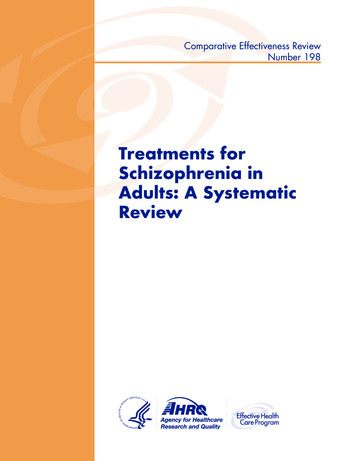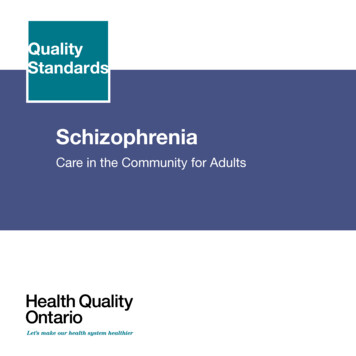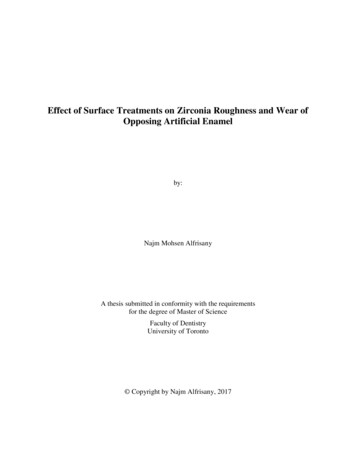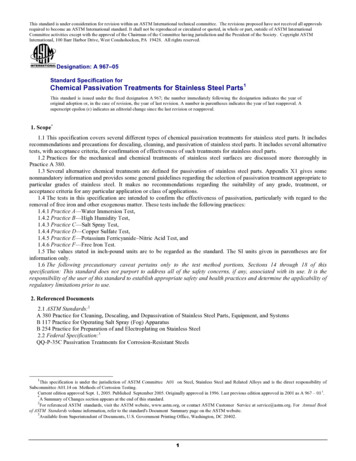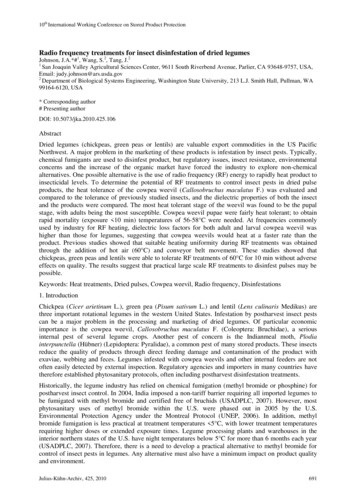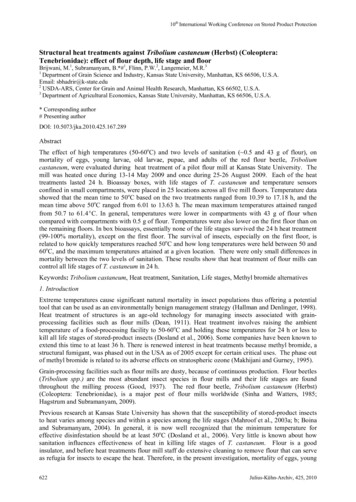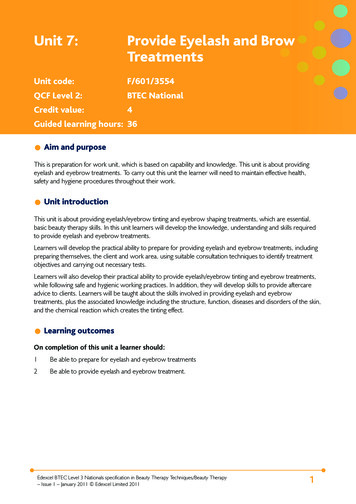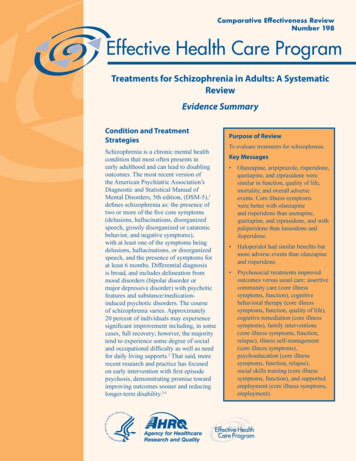
Transcription
Comparative Effectiveness ReviewNumber 198Effective Health Care ProgramTreatments for Schizophrenia in Adults: A SystematicReviewEvidence SummaryCondition and TreatmentStrategiesPurpose of ReviewSchizophrenia is a chronic mental healthcondition that most often presents inearly adulthood and can lead to disablingoutcomes. The most recent version ofthe American Psychiatric Association’sDiagnostic and Statistical Manual ofMental Disorders, 5th edition, (DSM-5),1defines schizophrenia as: the presence oftwo or more of the five core symptoms(delusions, hallucinations, disorganizedspeech, grossly disorganized or catatonicbehavior, and negative symptoms),with at least one of the symptoms beingdelusions, hallucinations, or disorganizedspeech, and the presence of symptoms forat least 6 months. Differential diagnosisis broad, and includes delineation frommood disorders (bipolar disorder ormajor depressive disorder) with psychoticfeatures and substance/medicationinduced psychotic disorders. The courseof schizophrenia varies. Approximately20 percent of individuals may experiencesignificant improvement including, in somecases, full recovery; however, the majoritytend to experience some degree of socialand occupational difficulty as well as needfor daily living supports.2 That said, morerecent research and practice has focusedon early intervention with first episodepsychosis, demonstrating promise towardimproving outcomes sooner and reducinglonger-term disability.3,4eTo evaluate treatments for schizophrenia.Key Messages Olanzapine, aripiprazole, risperidone,quetiapine, and ziprasidone weresimilar in function, quality of life,mortality, and overall adverseevents. Core illness symptomswere better with olanzapineand risperidone than asenapine,quetiapine, and ziprasidone, and withpaliperidone than lurasidone andiloperidone. Haloperidol had similar benefits butmore adverse events than olanzapineand risperidone. Psychosocial treatments improvedoutcomes versus usual care: assertivecommunity care (core illnesssymptoms, function), cognitivebehavioral therapy (core illnesssymptoms, function, quality of life),cognitive remediation (core illnesssymptoms), family interventions(core illness symptoms, function,relapse), illness self-management(core illness symptoms),psychoeducation (core illnesssymptoms, function, relapse),social skills training (core illnesssymptoms, function), and supportedemployment (core illness symptoms,employment).
Antipsychotic medications and nonpharmacologicaltreatments are typically used together when treatingindividuals with schizophrenia. Both pharmacologicaland nonpharmacological treatments for schizophrenia canresult in meaningful improvements in a variety of outcomeareas, including psychiatric symptoms, functioning(e.g., employment, social), service utilization (e.g.,hospitalization, crisis services), legal system involvement,quality of life, self-harm and aggressive behaviors,treatment engagement and retention, and co occurringsubstance abuse. Ideally, improvements in symptomstranslate to long-term, clinically relevant, positive changesin other outcome areas, with limited and manageableadverse effects.Although there are a large number of treatments forschizophrenia, it is not clear whether they afford longterm benefits on employment and social relationshipsand increase the likelihood of recovery, or what the mosteffective duration of treatment is. Equally important inselecting among competing interventions for a specificpatient is consideration of patient-level characteristics thatmay affect the outcomes across a diverse group of possibleinterventions.Scope and Key QuestionsScope of the ReviewThis systematic review provides a comprehensive reviewof current evidence that can help in determining howto treat individuals with schizophrenia. The reviewsynthesizes evidence on pharmacological treatmentscompared with each other and the general effectivenessof psychosocial and other nonpharmacological strategiescompared with usual care for treating individuals withschizophrenia, and highlights areas of controversy andareas for future research. The analytic framework (FigureA) illustrates the population, interventions, and outcomesconsidered. Due to a very large body of research literature,the review has been focused in several ways (see Methods).Older, first-generation antipsychotics (FGAs), such ashaloperidol, have proven efficacy but adverse effects,such as extrapyramidal symptoms and in some casestardive dyskinesia, often limit long-term adherence.Second-generation antipsychotics (SGAs), beginningwith clozapine, were introduced as having equal or betterefficacy, particularly with negative symptoms, and lowerrisk of extrapyramidal symptoms and tardive dyskinesia.SGAs have potentially serious adverse effects (e.g.,cardiovascular and endocrinologic effects) that make theiroverall risk/benefit profile less clear-cut than anticipated.2
Figure A. Analytic frameworkAdults withschizophrenia*Pharmacologial andpsychosocial andothernonpharmacologicaltreatments†Key Question 1, 2Benefits Outcomes for Key Questions 1 and 2 Functional–– Improvements in social and occupational functioning–– Enhanced ability to live independently/sstability–– Reductions in legal system encounters Reductions in self-harm, including suicide and suicide attempts Improvements in health-related quality of life (using validatedscales and including menal and physical health) Treatment discontinuation (e.g., treatment discontinuation/switching rate, time to discontinuation) Improvements in core illness symptoms (e.g., delusions,hallucinations, disorganized thinking)–– Rates of response, remission and relapse; speed andduration of response–– Total scale scores of positive (i.e., delusions andhallucinations) and negative (i.e., passive or apathetic socialwithdrawal and blunted affect) symptoms–– Reductions in agitation symptoms or aggressive behaviors Changes int eh status of co-occurring substance use disorderHarms OutcomesKey Question 1: Overall adverse events (frequency of any adverse events reported in trials) Withdrawals due to adverse events, time to withdrawal due to adverse events Mortality (all-cause and cause-specific as defined by studies) Significant (major) adverse eventsKey Question 2: Overall adverse events (frequency of any adverse events reported int rials) Withdrawals due to adverse events, time to withdrawal due to adverse events Mortality (all-cause and cause-specific as defined by studies) Worsening of symptoms ro new symptoms Other adverse events specific to intervention )e.g., negative effect on family or otherrelationships)* Adults with a diagnosis of schizophrenia, including those with co-occurring substance use disorders, and including thoseexperiencing a first episode of schizophrenia (including those with schizophreniform disorder).1. Pharmacological treatments:a. At least 90 percent of patients must have been diagnosed with schizophrenia.b. For studies specifically on harms of antipsychotic drugs, populations can be mixed-diagnoses, as the harms are not diagnosisspecific2. Psychosocial and other nonpharmacological treatments: 50 percent of patients must have been diagnosed with a schizophreniaspectrum disorder diagnosis (i.e., schizophrenia, schizoaffective disorder, or schizophreniform disorder)† Pharmacological treatments include US Food and Drug Administration-approved second-generation and selected first-generationantipsychotics. Psychosocial and other nonpharmacological treatments include: assertive community treatment, cognitive adaptivetraining, cognitive behavioral therapy, cognitive remediation/training, co-occurring substance use and schizophrenia interventions,early interventions for first episode psychosis, family interventions, intensive case management, illness self-management training,psychoeducation, social skills training, supported employment, and supportive therapy.3
Key QuestionsKey Eligibility Criteria1a. What are the comparative benefits and harmsof pharmacological treatments for adults withschizophrenia?Population(s): Adults with a diagnosis of schizophreniaInterventions: Key Question 1: Antipsychotic medications1b. How do the benefits and harms of pharmacologicaltreatments for adults with schizophrenia vary bypatient characteristics?a–– First-generation antipsychotic drugs (FGAs) Fluphenazine (Prolixin , Permitil ) Haloperidol (Haldol )2a. What are the benefits and harms of psychosocial andother nonpharmacological treatments for adults withschizophrenia? Perphenazine (Trilafon )–– Second-generation antipsychotic drugs (SGAs)2b. How do the benefits and harms of psychosocial andother nonpharmacological treatments for adults withschizophrenia vary by patient characteristics?a Aripiprazole (Abilify , Aristada ) Asenapine (Saphris ), Brexpiprazole (Rexulti )Methods Cariprazine (Vraylar )The methods for this systematic review follow the MethodsGuide for Effectiveness and Comparative EffectivenessReviews5 and are reported according to the PreferredReporting Items for Systematic Review and MetaAnalysis (PRISMA) checklist.6 The scope of the reportwas developed with consultation with a group of keyinformants. The details of the inclusion criteria, includingthe prioritized list of outcomes, were developed with inputfrom a group of technical experts. See the full report andthe review protocol (http://effectivehealthcare.ahrq.gov/index.cfm) for additional details on methods. Clozapineb (Clozaril , Fazaclo ODT,Versacloz ) Iloperidone (Fanapt ) Lurasidone (Latuda ) Olanzapineb (Zyprexa , Zyprexa Zydis ), Olanzapine Pamoate (Zyprexa Relprevv ) Paliperidoneb (Invega ) and Paliperidonepalmitate (Invega Sustenna , Invega Trinza ) Oral paliperidone is marketed only as anextended-release product, and will be notedas paliperidone in the report because there isno immediate-release formulation.Literature Search Strategy and Inclusion CriteriaA research librarian searched Ovid MEDLINE , theCochrane Library, and PsycINFO . For Key Question1, recent high-quality systematic reviews were used asthe starting point, such that our searches began in 2011for FGA versus SGA drugs and in 2013 for SGA versusSGA drugs. For Key Question 2, search dates were notrestricted. Searches were conducted through February 1,2017. Other standard search methods were also applied.Only English-language articles were included. A summaryof the eligibility criteria and review methods are describedbelow, and further details are in the full report. Quetiapineb (Seroquel , Seroquel XR ) The extended-release formulation is noted asquetiapine ER in this report; the immediaterelease formulation is not noted by a suffix tobe consistent with the other immediate releaseformulations of SGAs. Risperidoneb (Risperdal , Risperdal M-TAB ODT (oral dissolving tablet), Risperdal Consta ) Ziprasidoneb (Geodon )Patient characteristics include age, sex, race, ethnicity, socioeconomic status, time since illness onset, prior treatment history, cooccurring psychiatric disorders, pregnancy, etc.b“Older” SGAs; approved up through 2001 and included in the Clinical Antipsychotic Trials of Intervention Effectiveness (CATIE)trials.a4
Key Question 2: Psychosocial and othernonpharmacological interventionsc For each Key Question, eight outcomes were prioritizedas most important.–– Assertive community treatment–– Key Question 1: Functional outcomes, qualityof life, response and/or remission rate, mortality,reductions in self-harm, overall/any adverse events,improvements in core illness symptoms, andwithdrawal due to adverse events.–– Cognitive adaptive training–– Cognitive behavioral therapy–– Cognitive remediation/training–– Co-occurring substance use and schizophreniainterventions–– Key Question 2: Functional outcomes (includingsocial, occupational and other types of function),quality of life, reductions in self-harm, responseand/or remission rate, improvements in coreillness symptoms, treatment discontinuation (forany reason; may be reported as loss to followupor leaving study early), relapse rate, and adverseevents.–– Early interventions for first episode psychosis–– Family interventions–– Intensive case management–– Illness self-management training–– Psychoeducation Rehospitalization was not included as anoutcome because: (1) there is importantvariation in the indications for and lengthof psychiatric hospitalizations across time,in different localities, and with differentfinancial contexts, and (2) there is importantvariation across trials in how rehospitalizationis measured/evaluated, which may confoundstudy interpretation. However, it was reported inaddition to the prioritized outcomes for assertivecommunity treatment because it is the target ofthis intervention for patients with a history offrequent hospitalization.–– Social skills training–– Supported employment–– Supportive therapyComparators: Key Question 1: Head-to-head comparisons: FGAsversus SGAs, and SGAs versus SGAs. Key Question 2: Usual care/standard care/treatment asusual/waitlist, as defined in the trials.–– Usual care can consist of elements of medicationtreatment, medication management, casemanagement, rehabilitation services, andpsychotherapy. Both groups (treatment and usualcare) received usual care, including drug treatmentthroughout the study.Timing: Minimum duration of followup: 12 weeks.Settings:–– Evidence with active controls (other interventionswith expected benefit, or attention controls whichhave minimal or no benefit but similar patientparticipation time) was considered where theevidence base with usual care comparisons for agiven intervention is too small to draw conclusions(i.e., one or two trials, no systematic reviews). United States-relevant, such as countries listedas “high” or “very high” on the United NationsInternational Human Development Index (HDI), andapplicable to United States practices. Excluded: inpatient setting.Study designs:
22.04.2017 · * Adults with a diagnosis of schizophrenia, including those with co-occurring substance use disorders, and including those experiencing a first episode of schizophrenia (including those with schizophreniform disorder). 1. Pharmacological treatments: a. At least 90 percent of patients must have been diagnosed with schizophrenia. b. For studies specifically on harms of antipsychotic drugs .
